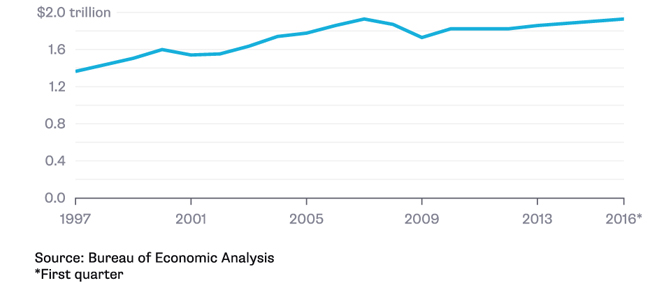U.S. manufacturing output is just now recovering from the plummet brought on when the housing industry bubble burst and the nation’s economy plunged into a recession.
As illustrated in the accompanying chart, which was current through the first quarter of 2016, real value-added manufacturing was back around the level reached before the housing industry collapse, approaching $2 trillion.
There’s a cloudy cover to that rosy news, however. Much of the growth in manufacturing output comes from one sector: computers and electronics, including semiconductors. If it was not for this industry, manufacturing output still would be below the 2008 peak, according to the W.E. Upjohn Institute for Employment Research. In fact, without that industry, manufacturing output would be only 8% higher than in 1997.
And it’s worth digging in further. Without adjusting for deflation, value-added manufacturing in the computer and electronics industry is up 45% since 1997. Adjusting for deflation, it is up 699%.
The U.S. Bureau of Economic Analysis has been trying to account for the huge improvements in the processing capacity — and quality — of computers, semiconductors and other electronics equipment.
However, the adjustments do a disservice, according to Susan Houseman, an economist with the institute. She says, “Because the computer and semiconductor industry, though small in dollar terms, skews the aggregate manufacturing statistics and has led to much confusion, figures that exclude this industry…arguably provide a clearer picture of trends in manufacturing output.”
That clearer picture shows that manufacturing is not booming.
Manufacturing still is the largest and most dynamic sector of the U.S. economy, though.
Globally, China became the leading manufacturing economy in the world in 2010, but the U.S. is still a strong No. 2.
What’s our nation’s No. 1 manufactured product? Refined oil. In 2014, the value of refined petroleum products was nearly $700 billion — more than four times larger than the No. 2 product, light trucks.
Our nation’s top exported manufactured product in 2015 was civilian airplanes (worth $63 billion). Next in line were auto parts ($58 billion), pharmaceuticals ($55 billion), autos ($55 billion), and those refined petroleum products ($46 billion).
Of course, manufacturing jobs have been in decline. The manufacturing sector has shed about five million jobs just since 2000. A major cause is productivity gains, producing more with fewer workers.




